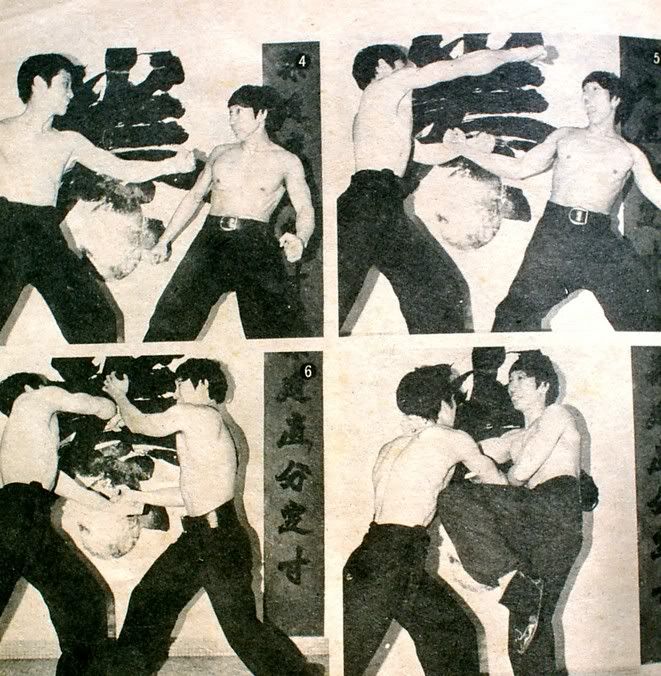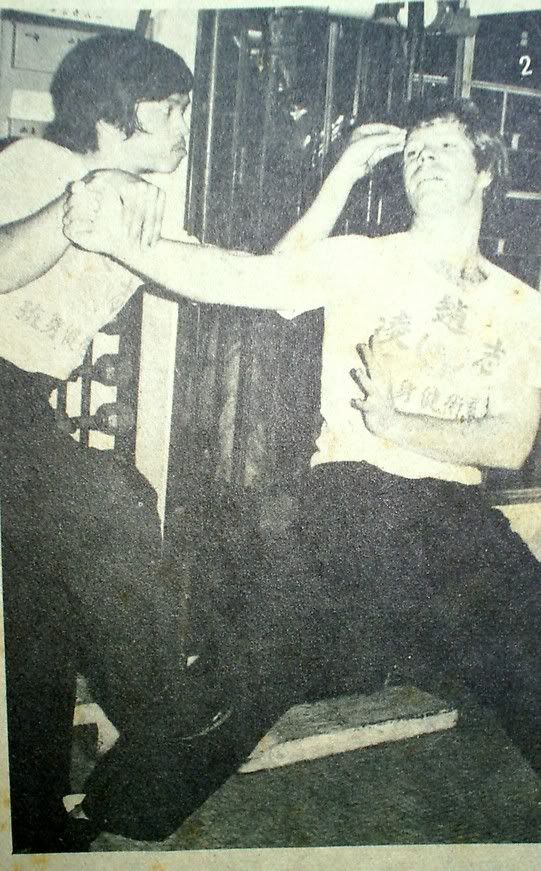|
|
Post by Eric Ling on Jan 16, 2005 21:49:33 GMT -5
|
|
|
|
Post by essence on Jan 19, 2005 13:46:59 GMT -5
Good day people.
There is a saying, You Qiao Po Qiao, Mei Qiao Shen Qiao. If there is a bridge, break it. If there isn't a bridge, grow one. Recently, I have been introduced to the concept of growing a bridge as a guard posture, putting the bridge out first and then countering when someone is trying to break your bridge, a rather new concept to me.
Usually, I have both hands bent at the elbows with palms facing up, hands forming a palm so as to quickly apply a palm or chin na as a guard posture to apply my bridges when an attack comes.
Anyone have anything like that? What are your guard postures? Do you prefer to let the opponent create the bridge or do you offer him your bridge?
Warmest regards,
Tze Hou
|
|
|
|
Post by Eric Ling on Jan 20, 2005 11:57:38 GMT -5
Good day people. There is a saying, You Qiao Po Qiao, Mei Qiao Shen Qiao. If there is a bridge, break it. If there isn't a bridge, grow one. Recently, I have been introduced to the concept of growing a bridge as a guard posture, putting the bridge out first and then countering when someone is trying to break your bridge, a rather new concept to me. Usually, I have both hands bent at the elbows with palms facing up, hands forming a palm so as to quickly apply a palm or chin na as a guard posture to apply my bridges when an attack comes. Anyone have anything like that? What are your guard postures? Do you prefer to let the opponent create the bridge or do you offer him your bridge? Warmest regards, Tze Hou Hey Tze Hou, First my apology for missing out on this terrific post of yours. “When there is a bridge break it, where there is none grow one” and “When there is a bridge, cross it. When there is none borrow one to cross” are but 2 of the many bridge concepts found in numerous kung Fu systems. My personal favorite has got to be; “When my hand (bridge) touches your hand, you got no where to go” or in Evert’s words “When my hand touches your hand, you are mine”. Which is the best strategy? Frankly, I equate this to “Which system is the best?” And to that I must answer; there is no definition. It is all up to the individual players. Or in the words of the great late Bruce Lee; my truth cannot be your truth. Which is also why I encourage exploring. Try out different things and you will find the one most suited to you. Learning is always a process and the moment you stop learning, you stop improving. Talk to you again. Eric |
|
|
|
Post by essence on Jan 20, 2005 13:55:46 GMT -5
Good day Eric.
Indeed, my truth cannot be your truth, this quote is most adequate.
When my hand touches yours, you are mine, I believe this is the concept Sifu Leong intended to show me when he showed me his guard posture.
In his words, I present you with my fist. If you take it, you will be taken.
Warmest regards,
Tze Hou
|
|
|
|
Post by Eric Ling on Jan 21, 2005 6:35:36 GMT -5
Hi Tze Hou,
Yes, you are right.
This concept is the nucleus of many CFK systems, northern/southern internal and external.
This brings me to my next point. Most CKF systems are built around principles/concepts. You heard me talk about this on many occasions.
Techniques are crafted using principles formulated by the founder and if you stay with any system long enough, this becomes apparent.
I would advise you to study principles as opposed to just collecting techniques.
Talk to you again.
Eric
|
|
Hungfist
Full Member
   ...gotta launder my Karma.
...gotta launder my Karma.
Posts: 120
|
Post by Hungfist on Jan 21, 2005 16:04:46 GMT -5
Hi Tze Hou, Yes, you are right. This concept is the nucleus of many CFK systems, northern/southern internal and external. This brings me to my next point. Most CKF systems are built around principles/concepts. You heard me talk about this on many occasions. Techniques are crafted using principles formulated by the founder and if you stay with any system long enough, this becomes apparent. I would advise you to study principles as opposed to just collecting techniques. Talk to you again. Eric This is why I keep coming back here. I would think this would be obvious to all...too bad its not. |
|
|
|
Post by Eric Ling on Jan 21, 2005 17:51:08 GMT -5
This is why I keep coming back here. I would think this would be obvious to all...too bad its not. Hahahaha Hungfist, Words were meant for our young friend Tze Hou. ;D ;D ;D |
|
Hungfist
Full Member
   ...gotta launder my Karma.
...gotta launder my Karma.
Posts: 120
|
Post by Hungfist on Jan 21, 2005 18:08:20 GMT -5
Hahahaha Hungfist, Words were meant for our young friend Tze Hou. ;D ;D ;D My apologies...I meant no offense to anyone. |
|
|
|
Post by essence on Jan 22, 2005 2:27:30 GMT -5
Good day Eric.
That is very good advice, I sort of picked out that trait while comparing what I know of NCK and Hung Gar. The techniques, although sometimes differing, would often be backing the same principles.
Thank you for that advice.
Gratefully,
Tze Hou
|
|
|
|
Post by Eric Ling on Feb 8, 2005 4:18:32 GMT -5
A Hung Gar technique application done by a young Chui Chi Lin.  |
|
|
|
Post by TenTigers on Feb 8, 2005 8:47:06 GMT -5
Tze Hou,
In some schools of Bak Mei they use a "sucker's lead" (street talk) meaning, if your left leg is forward, then your right hand is also forward,left hand by the elbow. In this case, your reach is deceptive-your (false) rear hand has more reach than anticipated Your blind side is deceptive-you can shift into the attack, and if you grab with your lead hand, you use your entire body to pull him in. Of course, fighting is not static, and if your opponent is fast and aggressive, you might find yourself with your horse crossed-meaning, he can jam in and close you off. Just a thought. Play with it and see what you think. My personal thoughts?-I don't believe in an on guard stance-either you are fighting or you aren't. And if you are fighting, then you should be attacking. If you are inside critical distance, the distance where your attacker can strike without taking a step-then you should either be attacking, or getting outside of critical distance. If you are outside, then you don't need a guard. I use a guard for drills. I am not a great fighter, so I don't have the luxury of being able to play chess with my opponent, feel him out, set him up, etc. I usually try to bum rush him with an all out barrage, and don't stop until it's done.
Then I run like hell. ;-)
|
|
|
|
Post by TenTigers on Feb 8, 2005 13:50:06 GMT -5
I wanted to mention a few things-one, since I just recently came to this forum, I have some "catching up" to do.
This being said, I wanted to just mention some thoughts on Hungry Tiger Catches the Lamb, and Fierce Tiger Overpowers the Wolf. I see the kewords to the applications being Lamb, and Wolf.
A lamb, being more passive, say your opponent is in his on guard position, and you immediately launch your attack, in a left leg forward stanceyou can use the left hand as a trap to the elbow,(pak) or covering the bridge,(lan) and strike right through your attacker with the Tiger Claw.
The Wolf represents an attacking animal, in which you will with courage and aggression, intercept his intent and drive through him.
The quote from Leung Daat's book concerning the water punch, seems to me to show that the element techniques are thrown without reserve.
What are your views on this interpetation?
|
|
|
|
Post by konghan on Feb 8, 2005 22:09:02 GMT -5
And for those of you who have never been to Singapore............     Very bueatiful, it makes me proud to be a chinese to see how nations rule by chinese develop and progress to become outstanding countries. |
|
|
|
Post by Nataraya on Feb 9, 2005 4:39:19 GMT -5
Quote: "The quote from Leung Daat's book concerning the water punch, seems to me to show that the element techniques are thrown without reserve".
What are your views on this interpetation?
Maybe it differs per school/ branch/ fighter, but in 99% of all cases there is "Lau", or reserve. Although the 18th keyword in our Kum Na list is Sat (kill), I would put full awareness in my attack, but will absolute reserve in case I have being trapped.
I can imagine that the thoughts behind "water" might be un- reserved, but we don't share that thought/ play. Relaxation and/ or softness, is the key. I mean, try to grab water with one hand, and see what I mean. But as I said (in the SFO) forum, there is no pure Element play, you see the same in the technique you mentioned. Two fists are presenting, which interact precisely to destroy (for instance) an elbow with the violence of a Tsunami.
But, there should 'controle', although hardly seen/ recognized in action.
This could be a long discussion, but I am afraid that you need to see/ and feel it. I am afraid that I lack too in the English language part. Sorry.
Regards,
Evert.
|
|
|
|
Post by Eric Ling on Feb 13, 2005 5:55:43 GMT -5
Here is another technique from Hung Gar. Like this one - notice the added "stomping kick".  |
|